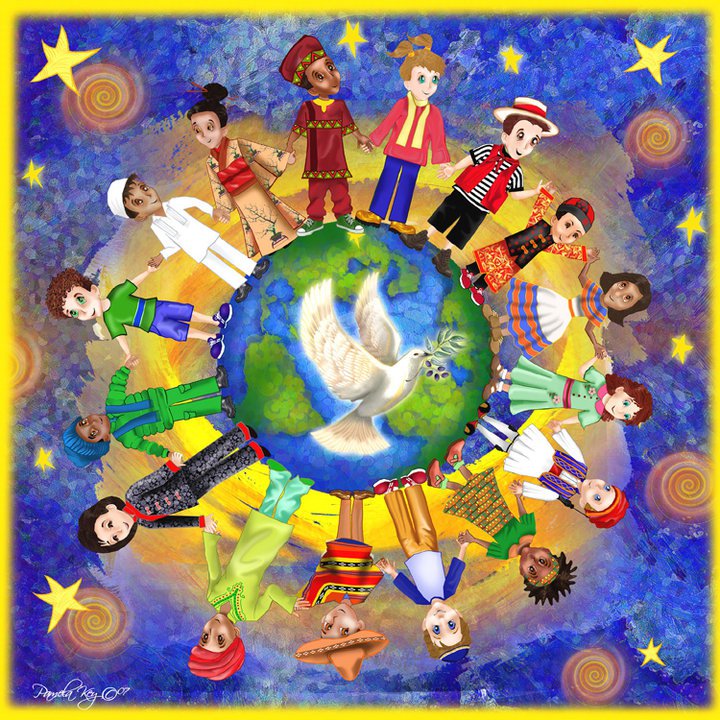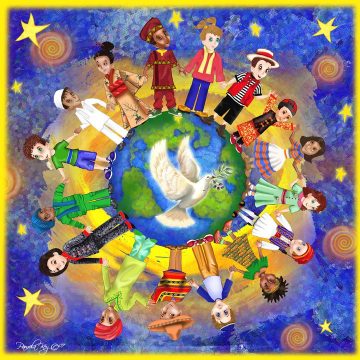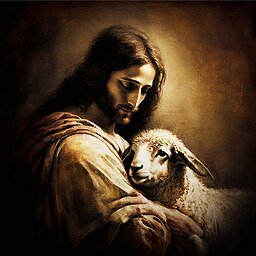By Amy Cartwright
Amy is a blogger for Young Mormon Feminists
My childhood was spent watching far too much television. While I would never admit this to my schoolmates, one of my favorite shows was none other than Barney and Friends. That’s right, I’m going to quote a purple dinosaur in this lesson. In one episode, the children are talking about different kinds of families—one child had a “traditional” family with a mom, dad, brothers and sisters, pets and the like, another had parents who were divorced, and one was raised by her grandmother. As the children sang about different kinds of families, they taught:
“A family is people and family is love,
that’s a family.
They come in all different sizes and different kinds,
but mine’s just right for me.”
The eternal nature of the family is one of the most beautiful doctrines in all of Mormonism. This understanding that we are sealed, not only to our spouses and children in nuclear families, but in one great big human family, should move us to compassion, love, and service of all of God’s children, regardless of their faith or non-faith, nationality, race, orientation, etc.
Too often we have a tendency in the Church to become tribal in our approach to the gospel. We create an us vs. them mentality when it comes to beliefs and practices, especially concerning families. Too often we dismiss families that do not conform to the “traditional” model as an attack and forget that we are all part of the human family as brothers and sisters in the Lord.
In her 1993 General Conference talk, Chieko Okazaki addressed the diversity of families both within and without the Church and reminded us that there are many, many ways to be a faithful Mormon woman, man, and family.
“All of us women have an image of the ideal family—a marriage in the temple to an active priesthood holder, and children who are obedient and faithful. But President Ezra Taft Benson has pointed out that only 14 percent of American households in 1980 match the traditional image of a family—working husband, full-time mother with children still in the home. Reliable statistics indicate that only one out of five LDS families in the United States have a husband and wife married in the temple with children in their home. As Elder M. Russell Ballard has already reminded us, there is great diversity in LDS homes. But all of these homes can be righteous homes where individuals love each other, love the Lord, and strengthen each other.
“Let me give you an example. Here are two quilts. Both are handmade, beautiful, and delightful to snuggle down in or wrap around a grandchild. Now look at this quilt. It’s a Hawaiian quilt with a strong, predictable pattern. We can look at half of the quilt and predict what the other half looks like. Sometimes our lives seem patterned, predictable in happy ways, in order. Now look at this second quilt. This style is called a crazy quilt. Some pieces are the same color, but no two pieces are the same size. They’re odd shapes. They come together at odd angles. This is an unpredictable quilt. Sometimes our lives are unpredictable, unpatterned, not neat or well-ordered. Well, there’s not one right way to be a quilt as long as the pieces are stitched together firmly. Both of these quilts will keep us warm and cozy. Both are beautiful and made with love. There’s not just one right way to be a Mormon woman, either, as long as we are firmly grounded in faith in the Savior, make and keep covenants, live the commandments, and work together in charity. (“Strength in the Savior”, General Conference, October 1993).”
Just as there is no “one right way” to be a quilt or a Mormon woman, there is no “one right way” to be in a family. From Esther in the part-member family, Ruth the widowed and childless, to Bilhah and Zilpah the unwed mothers, and Deborah the career woman, the scriptures give us account after account of women who were in non-“traditional” families, but because of their faith and courage, they were able to do great things. Through their stories and the countless examples of modern-day Mormon women and their families, we learn that it’s not so much about having the idealized family to find and worship God, but to find and worship God regardless of the type of family we inhabit.







20 Responses
How on earth did Chieko Okazaki get into the general relief society presidency? She seems just too awesome to be allowed.
Great post, Amy.
Would have liked to see some more “meat” from the lesson manual instead of just an editorial on how important all families are – traditional and non-traditional. Although I agree with what you’ve written, there are some great quotes from this lesson on the eternal importance of families and the need to strengthen our families. There are also some great points in the manual that can be tied into the Family Proclamation. I agree that families, as well as women come in all shapes and sizes with different strengths and abilities, but I don’t think it’s healthy to ignore the fact that Heavenly Father has taught there is IS an ideal standard in regard to our earthly families.
Julie E., did you know that all these lessons are done by volunteers who do not hold the Relief Society teacher calling? They do these lessons in addition to the callings they hold at the local level. And, as you know, it take hours of study and prep to get a lesson ready. I think the awesome part of this forum is we have the opportunity to see different teachers’ ideas on how to approach the lesson.
I hope you and others reading this thread will take the time to share your ideas for presenting the topic and favorite quotes you’ll be using as you prepare.
Think you for your feedback, Julie. Truth be told, I was finishing this up with a baby screaming on my lap who refuses to sleep these days, so much of my lesson was cut because I didn’t feel like it was working as a coherent whole. It does need some more fleshing out. Overall, my hope was to add some thoughts that could be useful for those who may feel left out of this lesson because they do not fit the pattern. They will likely have many, many opportunities to hear about the “ideal,” so I feel that area is already good and covered in the standard RS lesson.
First, a big THANK YOU to those who take time to share notes and thoughts regarding lessons. I come here often for ideas and thoughts and do enjoy reading various perspectives, and often see things differently after reading these posts. 🙂
After spending a lot of time reading and studying this lesson today I think I really want to focus a lot on the final section of the lesson. I LOVE the second paragraph and think it can relate to any family situation – as a child, parent, wife, sister, daughter, aunt, grandmother, etc. Are we each spending the time time needed to make our families successful?
I love your examples here, Amy! Thank you so much for this lesson.
I wonder (this question is to the group at large)–how would you, as a teacher, handle the discussion if someone decides to make a statement about gay marriage hurts families?
Emily, that is a great question. If I were teaching this lesson and a comment was made about marriage equality being damaging to the family, I’d gently point to some statistics and ask for compassion and understanding. Because I live in Utah, I’d indicate that in our state, about 1/3 of all LDS people support marriage equality, which would mean that about 1/3 of the women in the room do. I’d also remind everyone that there are sisters in the room at this time who are either LGBT, have LGBT family members, or LGBT friends. Then, I’d give my opinion that marriage equality is not damaging my family at all. Then to soften the blow, I’d say, “i understand that my opinion is not that of the church, but we are allowed to have our own opinions on this and every political issue.”
One of the teachings I have always loved in Mormonism is the belief that the whole human family must be sealed up as a collective whole in order for each of us to be saved individually. As a church and a culture I often wonder how we came from this expansive vision of the eternal family, to one so focused on an idealized version of the nuclear family. Chieko’s quilt analogy and Amy’s focus in this lesson feel so deeply Mormon to me. Thank you for this.
Love this; I’m teaching this lesson next week and plan to plagarize you. Can I use the picture for a handout?
I also, agree with Julie! We must be careful to not confuse strength in family, through diversity in situations with important family covenants that really are the Eternal glue, in keeping our families together. Plus the Eternal blessing that come with those kept covenants! I love the idea of the quilts! The analogy there could be, whatever quilt we are be a strong quilt, one that will hold up well, under lots of wear, wash, rips , ect….. Until the time comes to get a new one( temple covenants). Woman are strong! They in no way want to fail!!! Everyone would love the next step in our Eternsl climb(a new quilt). Be strong on the level you are at, the lord knows how hard you are trying and reach, when your quilt is worn out, and you need a new one! He will hand you a new quilt!
I plan to focus on eschewing the checklist and enjoying your kids and embracing uniqueness. I’m handing out a picture of my great grandparents with pretty roses around it and this : ” Remember, as far as anybody knows, we are a nice normal family.”
That sounds like a wonderful idea, Anne!
Can I copy the picture?
For your lesson? I imagine that would be lovely. Of course 🙂
I love the quilt idea. I live in a VERY diverse ward with people in all different walks of life. To say the least, it is definitely NOT the “typical” ward. With that said, I always approach lessons regarding families in a very gentle way because many in our ward are not in the typical predictable quilt.
One of the things that struck me about this lesson, after reading it over and over, was in the actual title. Strengthening and PRESERVING the family. At first I thought of “preserving” as in canning. But then I thought more in terms of a life preserver. Although we are each on our own journeys on our path to life eternal, Satan is more determined than ever to make wrong appear right and right appear wrong. If he can break apart the family, his job is so much easier. The image of a life preserver thrown to a person drowning in an ocean of high waves in a storm and a lighthouse guiding the path of the ship keeps coming to mind.
Thank you for taking the time to think about these lessons and to write about them. It really helps me to gather my thoughts in considering what the sisters in my ward need to hear.
Fantastic quote. I, too, struggled with the tone of this lesson and the analogy of the quilts was the perfect balm. Thank you!
I used a lot of this in my lesson, substituting “orientation” with “gay or straight.” It went pretty well, except for my shaky voice and knees.
[…] taught RS a couple of weeks ago for a friend who was out of town. I used this from Exponent https://exponentii.org/relief-society-lesson-4-strengthening-and-preserving-the-family/comment-… and focused a lot on a couple of quotes from Marjorie Hinckley urging women to accept themselves […]
[…] Image from The Exponent […]
Amy (or anyone), do you happen to have the source for the photo on the very top? (“The Children holding hands around the earth with the white dove in the middle”). I have been searching the internet in hopes I would find the original so I can have it printed as a poster or on canvas for my daughter’s room.
Thank you in advance,
Stefanie.